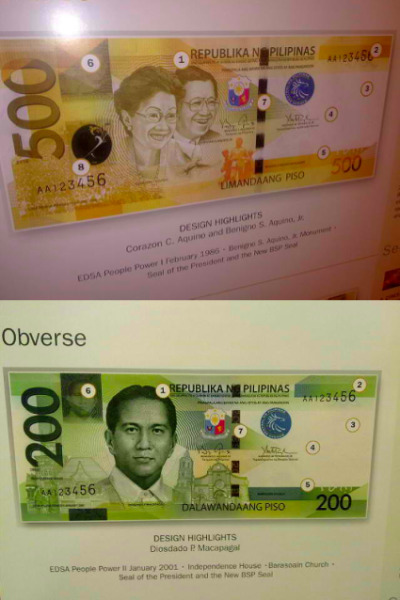
All six denominations — P20, P50, P100, P200, P500, and P1,000 — have new designs and security features. Below are the new designs:
P20 bill
Obverse: Manuel L. Quezon
Reverse: Banaue Rice Terraces and a palm civet from the Cordilleras, which are famous for producing the coffee alamid
P50 bill
Obverse: Sergio Osmeña
Reverse: Taal Lake and the Giant Trevally (locally known as Maliputo), a delicious milky fish which thrives only in the waters of the lake.
P100 bill
Obverse: Manuel A. Roxas
Reverse: Mayon Volcano and “butanding” or whale shark, the world’s largest living fish which is the main attraction of Donsol, Sorsogon
P200 bill
Obverse: Diosdado Macapagal
Reverse: Chocolate Hills and the Philippine tarsier, one of the world’s smallest primates
P500 bill
Obverse: Corazon Aquino and Benigno “Ninoy” Aquino Jr.
Reverse: Puerto Princesa Subterranean River National Park and the blue-naped parrot, which thrives in the forests of Palawan and Mindoro
P1,000 bill
Obverse: Josefa Llanes Escoda, Vicente P. Lim, and Jose Abad Santos
Reverse: Tubbataha Reef Marine Park and the South Sea Pearl, which is produced by oysters that thrive in the South Seas which the Sulu Sea is a part of
The images of the national figures on the obverse side of the bills show them at a younger age. Fe Dela Cruz, director of the BSP’s corporate affairs office, said in an ambush interview the younger images were chosen because the public servants and heroes on the bank notes served the country during their prime.
The new security features of the bank notes include embossed prints, serial numbers, security fibers, watermarks, security thread, optically variable device, optically variable ink, and a see-through mark. The features increase as the value of the note goes higher.
The see-through mark is the word “Pilipino” written in Baybayin, a pre-Spanish Philippine writing system, which is only seen in complete form when the note is viewed against the light.
A banknote’s design is first conceptualized before it is drawn by an artist into a prototype banknote. Once the prototype has been approved, printing plates will be produced.
The production of banknotes consists of litho printing; intaglio printing; sheet inspection; numbering; tenning (where numbered sheets are inspected every tenth sheet to check if there are defects); and finishing which includes cutting, counting and packaging, according to the BSP.
Share
